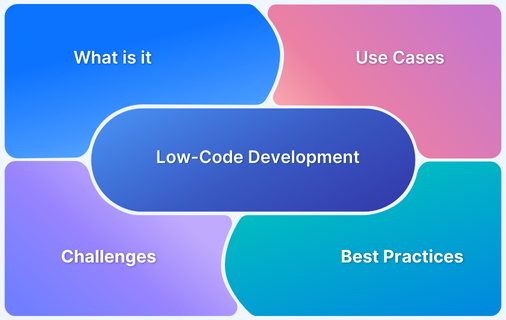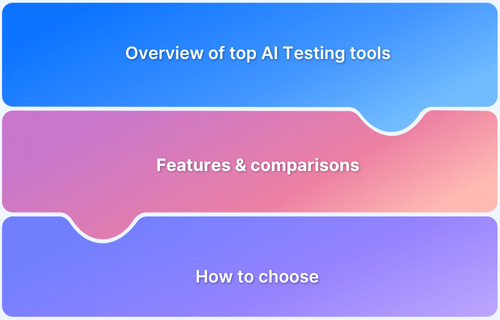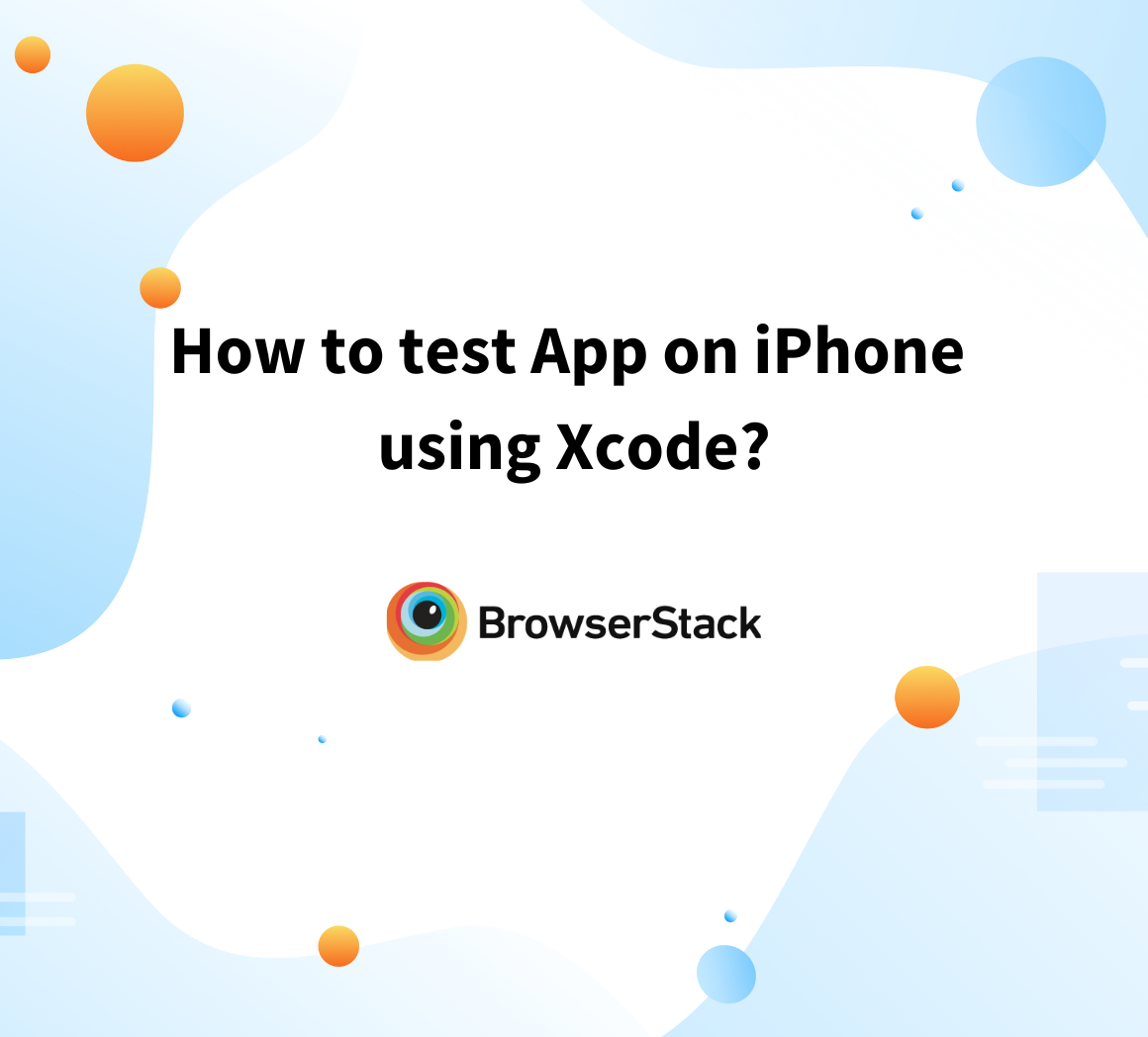Record-playback testing is a low-code approach where a tool captures user actions on an app’s UI and converts them into reusable test scripts. These scripts can be replayed to automate tasks, validate functionality, and speed up testing without coding expertise.
Overview
How it Works
- Record: Tester performs actions on the application.
- Capture: Tool logs each step as a script.
- Playback: Steps are replayed automatically to test functionality.
- Verify: Assertions confirm expected results.
Top Record and Playback Testing Tools
- BrowserStack Low Code Automation: Record and run UI tests on real devices in the cloud.
- Katalon Studio: All-in-one automation platform with record and playback support.
- TestSigma: AI-driven test automation with scriptless recording.
- testRigor: Plain English test creation with record and playback.
- BugBug: Lightweight recorder for fast web app test automation.
- TestGrid: Cloud-based recorder with cross-platform test execution.
This article explores record and playback testing in detail. It covers the concept, how it works, its benefits, core features, commonly used tools, a step-by-step workflow, challenges, and best practices.
What is Record and Playback Testing?
Record and playback testing is an automated method where a tool records user actions on an interface, such as clicks, text entry, and navigation.
Once the recording stops, the same steps can be replayed as a test case. The tool captures element locators and checks, so the sequence can run automatically without writing code. This makes it easier to convert manual flows into repeatable tests.
Recorded tests are often used for regression checks or added to continuous integration pipelines to confirm that recent changes have not disrupted existing features or broken critical user journeys.
Read More: Locators in Selenium: A Detailed Guide
How Record and Playback Testing Works
The typical mechanism of record and playback testing involves the following components:
- Recorder: A module or plugin that captures user actions. These include mouse clicks, keyboard inputs, selections, navigation, and sometimes even more complex gestures (drag-and-drop, hover).
- Element Locators & Assertions: While recording, the tool also captures identifiers (like IDs, CSS selectors, XPath) for UI elements, and sometimes assertions to verify that UI behaves as expected (e.g. that some text appears, or an element is visible).
Learn More:Xpath Vs CSS Selector: Key Difference
- Playback / Runner: The recorded script is replayed. The runner plays back actions in the same order. It may include wait times, synchronization so that the UI has loaded or elements are ready.
- Editing / Maintenance: After recording, the test script often needs editing: remove unnecessary steps, adjust locators (if changes happen), insert assertions, parameterize data or make reusable modules.
- Execution in multiple environments: Once ready, tests are run across different browsers, devices, or configurations. That helps catch cross-browser or cross-device UI issues.
- Results & Reporting: After playback, the tool reports which steps passed or failed, logs errors, sometimes captures screenshots or video, and helps debug failures.
Core Features of Record and Playback Testing
To deliver consistent results, record and playback testing needs features that reduce fragility, enable scalability, and improve long-term usability. Here are a few important ones:
- Stable locators: Element identifiers should remain reliable even after minor UI changes. Weak locators make tests brittle, causing frequent failures and heavy maintenance work.
- Assertions: Tests must validate outcomes such as text presence, element visibility, or the correct state. Assertions confirm that the application behaves as expected after each step.
- Editing: Tools should allow modification of recorded scripts. Users need to add, delete, or change steps, update locators, and insert logic to refine test accuracy.
- Parameterization: The same test must run with different inputs, such as multiple login credentials. This expands coverage without duplicating recorded steps.
- Cross-browser execution: Tests should run across browsers, operating systems, and devices. This ensures consistent functionality for all users regardless of environment.
- Parallel execution: Running tests concurrently cuts execution time for large suites. Parallelization delivers faster results and supports frequent builds within development pipelines.
- Maintenance: Features like self-healing locators, retry logic, and smart waits reduce fragility. Version control helps teams manage test updates as the application evolves.
- Reporting and debugging tools: Detailed logs, screenshots, and video help track failures. Clear reporting makes it easier for testers and developers to diagnose and fix issues.
Read More: What is Assertion Testing?
Record and Playback Testing Tools
There are multiple record and playback testing tools available today. This section explains each tool’s features, benefits, and how it helps streamline test automation.
1. BrowserStack Low Code Automation
BrowserStack’s Test Recorder empowers teams to perform low-code test automation without writing code. By recording interactions on the application, testers and non-technical team members can quickly create automated UI tests, edit them with ease, and visually validate results. This makes automation more collaborative, resilient, and faster to adopt across teams.
With its intuitive recorder interface, BrowserStack removes the complexity of scripting, reduces test maintenance, and ensures reliable execution across environments.
Key Features of BrowserStack Test Recorder:
- Record and Playback Testing: Capture interactions on the application UI by performing user actions. Replay them anytime to validate functionality without manual effort.
- Easy Test Authoring: Create tests with no coding required. User actions are instantly converted into automated test steps.
- Visual Validation: Check critical UI elements with snapshot-based visual checks, removing the need for complex assertions.
- Easy Test Editing: Edit steps in a recorded test without starting from scratch. Modify actions or validations with a few clicks.
- Readable Test Steps: Automatically generated, human-readable descriptions make tests easy for any team member to understand.
- Smart Auto-Waiting: Boost reliability with adaptive wait times that respond to network conditions and UI performance.
- Self-Healing Tests: Cut down flakiness with AI-powered smart selectors that adapt to UI changes, reducing maintenance and failures.
Try BrowserStack Low Code Automation
2. Katalon Studio
Katalon Studio offers a hybrid environment where tests can be built via record and playback, keyword/low-code scripting, or full code. It supports web, mobile, and API testing and integrates with CI/CD, dashboards, and analytics.
Key Features / USPs
- Multi-platform support
- Built-in recorder
- Data-driven testing
- Smart wait handling
- Test object repository
- Parallel execution
- CI/CD pipeline support
Key Benefits
- One tool handles different test types (UI, API, mobile).
- Teams can start without coding and gradually adopt scripting.
- Flaky test reduction improves repeatability.
- Integration helps automation tie into the release process.
- Visibility into test results helps debug and prioritize fixes.
Katalon Studio offers a mature, hybrid automation approach that fits teams growing from non-technical to technical needs, with good stability and insights.
Read More:Katalon Alternatives
3. TestSigma
Testsigma is a cloud-based, low-code, AI-driven test automation platform. It uses plain English for test definition, supports web, mobile, API automation, deep dashboards, integrations, and works from any machine via browser.
Key Features / USPs
- Natural language tests
- Cloud-hosted platform
- Recorder for test steps
- Reusable test assets
- Cross-platform support
- Parallel executions
- CI/CD integration
Key Benefits
- Faster test creation for less technical users.
- Good test stability across browsers and devices.
- Better visibility into failures with dashboards.
- Reduced manual overhead via AI tools.
- Seamless tie-in with deployment pipelines saves time.
Testsigma offers simple test authoring plus strong automation coverage, useful for teams wanting fast setup without sacrificing stability.
Learn More: TestSigma Alternatives
4. testRigor
testRigor enables test automation via plain English, not relying on locators. It supports web, mobile, desktop, API, and handles complex flows such as emails, MFA, and file downloads. Maintenance is low and adaptability high.
Key Features / USPs
- Plain English commands
- No locator reliance
- Test recorder support
- Cloud execution
- API testing support
- CI/CD integration
- Parallel execution
Key Benefits
- Very low test maintenance; UI changes have fewer breaking effects.
- Everyone can read and understand tests, not just coders.
- Broad platform coverage lowers the need for separate tools.
- Reusable components speed up test suite growth.
- Rich debug info (screenshots/videos) helps fix failures faster.
testRigor offers an end-to-end testing path that lowers technical overhead and keeps tests stable as applications evolve.
Read More:testRigor Alternatives
5. BugBug
BugBug is a codeless web application test tool. It works via a Chrome extension to record, edit, execute tests. It supports local and cloud runs, dynamic data, smart waits, reusable components, and collaboration.
Key Features / USPs
- Browser-based recorder
- Visual test editor
- Data-driven testing
- Team collaboration
- Cloud scheduling
- Fast setup process
- API integration
Key Benefits
- Fast onboarding for small teams; minimal setup.
- Free local test runs help experimentation.
- Fewer flaky tests via smart waits/selectors.
- Shared workspaces help multiple contributors.
- Options to scale to cloud execution when needed.
BugBug works well for teams that need lightweight, web-based test automation without large overhead, yet want the capability to grow.
6. TestGrid
TestGrid is an end-to-end testing platform. It supports real device & browser testing, scriptless/codeless test building, AI features, visual validations, integrations, performance and security testing. Aims to suit both technical and non-technical users.
Key Features / USPs
- Multi-device support
- Cloud test execution
- AI-based locator handling
- Data-driven testing
- Recorder for test flows
- Parallel execution
- CI/CD integration
Key Benefits
- Broad test coverage across devices and browsers.
- Scriptless flows let non-technical testers contribute.
- Detect visual regressions early.
- Faster feedback through parallel runs.
- Centralised dashboards help track test health and performance.
TestGrid suits teams that need wide platform coverage, visual checks, and flexible test building without deep coding.
Step-by-Step Workflow of Record and Playback Testing
Record and playback testing typically follows a structured workflow as described in the steps above:
Step 1: Select the test flow: Choose a user journey to automate using record and playback testing. Pick stable flows like login, purchase, or form submission that do not change often.
Step 2: Set up the tool: Install the recorder or browser extension and configure the environment. Include browsers, devices, accounts, and any settings needed for the tests.
Step 3: Record the test: Start the recorder and perform the steps manually. Capture navigation, form fills, clicks, and add checkpoints to verify expected results.
Step 4: Stop recording: Finalize the test and save it carefully. This recorded script becomes the baseline for playback and future automated runs.
Step 5: Review and edit: Remove redundant steps, adjust locators to stable identifiers, add or modify assertions, and parameterize data for reusable tests.
Step 6: Run the test: Execute the test locally or in the cloud. Verify the recorded steps run correctly and produce consistent results.
Step 7: Run in different environments: Replay tests across multiple browsers, devices, and screen sizes to confirm the application behaves consistently in all setups.
Step 8: Integrate into CI/CD: Schedule automated runs or link tests to build and deployment pipelines so they execute with every code change or release candidate.
Step 9: Report & debug failures: Capture logs, screenshots, or videos for failed runs. Analyze broken locators or UI changes, then update or fix the test script.
Step 10: Maintain the suite periodically: Review the test suite as the application evolves. Update tests, remove obsolete ones, and ensure the suite stays reliable and relevant.
Limitations and Challenges of Record and Playback Testing
Record and playback testing provides a simple way to automate user flows, but it has several limitations and challenges that can affect reliability, scalability, and flexibility.
- Fragile tests: In record and playback testing, locators for UI elements can break when IDs, CSS, or page structure change. This makes automated tests fragile and prone to frequent false failures.
- Limited logic: Record and playback testing struggles with complex logic such as loops, conditionals, dynamic content, and branching flows. Recorded scripts cannot easily represent these advanced scenarios.
- Excess noise: Record and playback testing often captures unnecessary actions like extra mouse movements, clicks, or waits. This creates long, slow, and harder-to-read test scripts.
- Maintenance overhead: UI changes require frequent updates to recorded scripts. Record and playback testing demands continuous maintenance to keep tests accurate and prevent false failures.
- Scalability issues: Large suites in record and playback testing take longer to run due to repeated execution. Modular scripts and parallel execution are needed to manage scale effectively.
- Lack of customization: Recorded tests in record and playback testing have limited reuse, data parameterization, or custom logic. This reduces flexibility for advanced test scenarios.
- Limited integration: Some record and playback testing tools do not integrate well with CI/CD pipelines, test management systems, or version control, making workflow automation harder.
- Not suitable for all test types: Record and playback testing cannot handle performance testing, backend logic verification, or non-UI test cases effectively. These require specialized approaches.
Also Read:How to handle Click Events in Cypress
Best Practices for Record and Playback Testing
To get the most value from record and playback testing and to further maximize its effectiveness, teams should follow structured workflows and apply best practices outlined below.
- Choose stable flows: Select repeatable, low-change user journeys for record and playback testing, like login, form submissions, or checkout processes, to minimize fragile scripts.
- Use reliable locators: Replace absolute paths with stable element locators. Record and playback testing relies on consistent identifiers like IDs, CSS classes, or text values for accuracy.
- Insert assertions strategically: Add checkpoints to verify important application states. In record and playback testing, assertions prevent silent failures and ensure the user journey produces correct results
- Parameterize data: Use data-driven testing to run the same record and playback script with multiple inputs. This improves coverage and reduces the need to duplicate test cases.
- Modularize tests: Break long recorded flows into reusable modules. Record and playback testing becomes easier to maintain and more flexible when steps are separated logically.
- Leverage cross-browser/device testing: Run tests across multiple browsers and devices. Record and playback testing benefits from this to catch compatibility issues before deployment.
- Maintain scripts regularly: Review and update record and playback testing scripts when UI or functionality changes. Regular maintenance prevents failures and ensures reliability.
- Integrate with CI/CD: Include record and playback testing scripts in continuous integration or delivery pipelines. Automated execution with each build provides fast feedback and early defect detection.
- Keep tests simple: Avoid over-complicating recorded scripts. In record and playback testing, simpler tests are more stable, easier to debug, and less likely to break after minor UI changes.
Conclusion
Record and playback testing provides a practical way to automate user flows without extensive coding, making it suitable for regression checks and repetitive tasks.
Although it has limitations such as fragile tests, maintenance requirements, and reduced flexibility for complex logic, following structured workflows and best practices can maximize its benefits.
To accelerate test creation and reduce manual effort, teams can use BrowserStack Low-Code Automation. It combines a simple recorder with AI-driven self-healing to enable maintainable record-and-playback tests across devices and environments.








